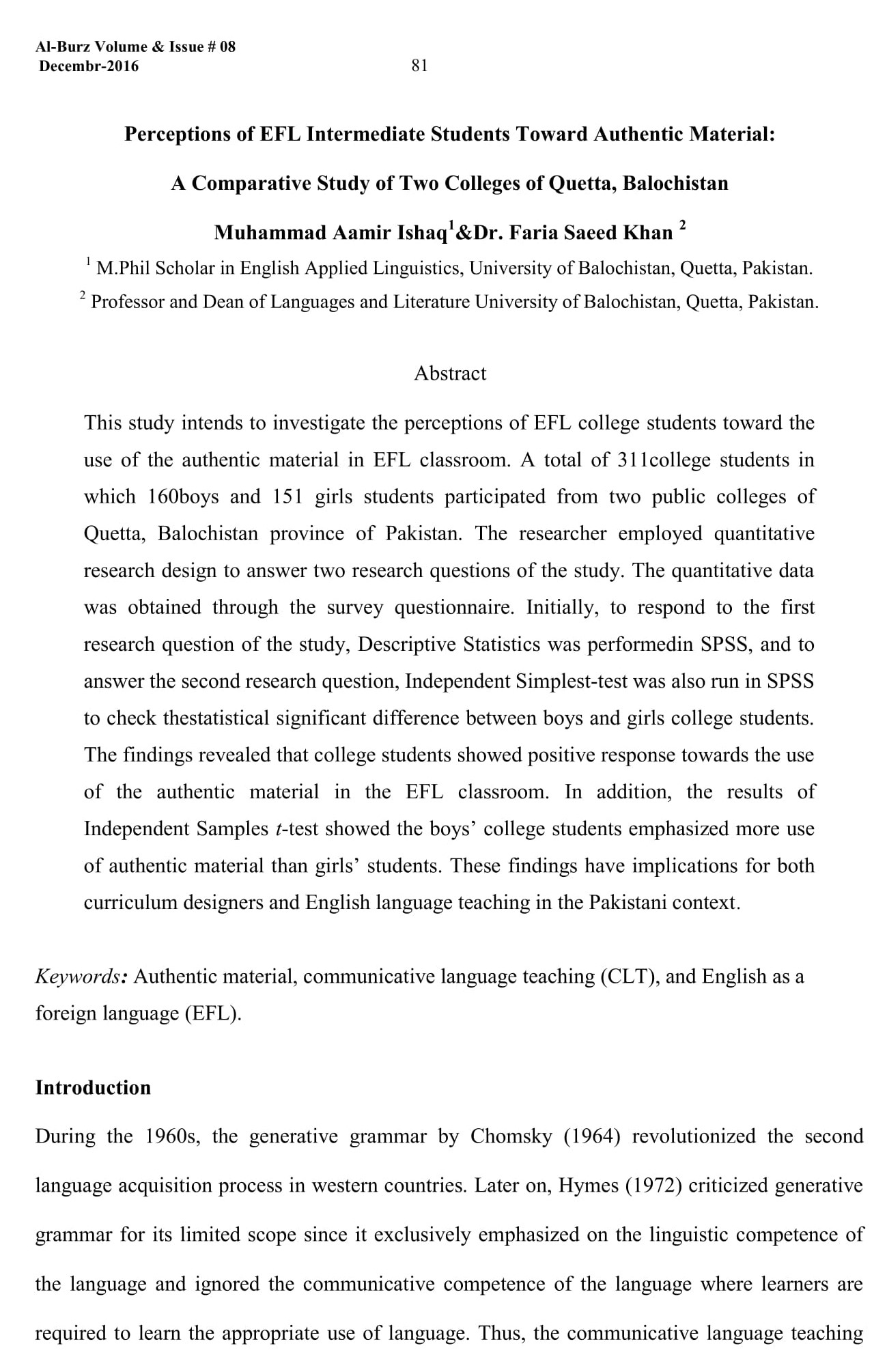Perceptions of EFL Intermediate Students Toward Authentic Material: A Comparative Study of Two Colleges of Quetta, Balochistan
DOI:
https://doi.org/10.54781/abz.v8i1.133Keywords:
Authentic material, communicative language teaching (CLT), and English as a foreign language (EFL)Abstract
This study intends to investigate the perceptions of EFL college students toward the use of the authentic material in EFL classroom. A total of 311college students in which 160boys and 151 girls students participated from two public colleges of Quetta, Balochistan province of Pakistan. The researcher employed quantitative research design to answer two research questions of the study. The quantitative data was obtained through the survey questionnaire. Initially, to respond to the first research question of the study, descriptive statistics was performed in SPSS, and to answer the second research question,independent simplest-test was also run in SPSS to check thestatistical significant difference between boys and girls college students. The findings revealed that college students showed positive response towards the use of the authentic material in the EFL classroom. In addition, the results of independent samples t-test showed the boys’ college students emphasized more use of authentic material than girls’ students. These findings have implications for both curriculum designers and English language teaching in the Pakistani context.
References
Akbari, O., & Razavi, A. (2015). Using authentic materials in the foreign language classrooms: Teachers’ perspectives in EFL classes. International Journal of Research Studies
in Education, 5(2).
Bacon, S. M., & Finneman, M. D. (1990). A study of the attitudes, motives, and strategies of university foreign language students and their disposition to authentic oral and written input. The Modern Language Journal, 74(4), 459-473.
Creswell, J. W. (2012). Educational research: Planning, conducting, and evaluating quantitative and qualitative research (4th ed.). Boston: Pearson Education, Inc.
Dornyei, Z. (2003). Attitudes, orientations, and motivations in language learning: Advances in theory, research, and applications.Language Learning, 53, 3-32.
Guo, S. C. (2012). Using authentic materials for extensive reading to promote English proficiency. English Language Teaching, 5(8), 196.
Hymes, D. (1972). On communicative competence. Sociolinguistics, 269293, 269-293.
Jiaju, Z. (1984). Making use of news broadcasts. ELT Journal, 38(4), 242-247.
Karimi, M., & Dowlatabadi, H. R. (2014). Authenticity vs. Practicality: Metacognitive Awareness through Authentic materials in EFL class room.Procedia-Social and Behavioural Sciences, 98, 844-851.
Kilickaya, F. (2004). Authentic materials and cultural content in EFL classrooms. The Internet TESL Journal, 10(7).
Masgoret, A. M., & Gardner, R. C. (2003). Attitudes, motivation, and second language learning: a meta–analysis of studies conducted by Gardner and associates. Language learning, 53(1), 123-163.
McCoy, P. (2009). Using authentic materials: Keeping it real. In Conference on Teachers Helping Teachers (THT), February, Philippines.
Morrison, B. (1989). Using news broadcasts for authentic listening comprehension. ELT journal, 43(1), 14-18.
Mousavi, S. A., & Iravani, H. (2012). The effect of authentic versus non-authentic aural materials on EFL learners' listening comprehension. English Language and Literature Studies, 2(1), 21.
Nuttall, C. (1996) Teaching reading skills in a foreign language, (New Edition) Oxford, Oxford University Press.
Pallant, J. (2013). SPSS survival manual. McGraw-Hill Education (UK).
Rogers, C., & Medley, F. (1988). Language with a purpose: Using authentic materials in the foreign language classroom. Foreign Language Annals, 21, 467-478.
Sun, Z. (2010). Language teaching materials and learner motivation. Journal of Language Teaching and Research, 1(6), 889-892.
Warsi, J. (2004). Conditions under which English is taught in Pakistan: An applied linguistic perspective. Sarid Journal, 1(1), 1-9.
Widdowson, H. (1990). Aspects of language teaching. Oxford: Oxford University Press.
Wu, T. T., Sung, T. W., Huang, Y. M., Yang, C. S., &Yang, J. T. (2011). Ubiquitous English learning system with dynamic personalized guidance of learning portfolio. Educational Technology & Society, 14(4), 164-180.
Zoghi, M., Moradiyan, F., & Kazemi, A. (2014). The effects of authentic materials on vocabulary development. Retrieved January 11, 2015.

Downloads
Published
How to Cite
Issue
Section
License
Copyright (c) 2021 Alburz

This work is licensed under a Creative Commons Attribution-NonCommercial-ShareAlike 4.0 International License.
Alburz has licensed under a CC Attribution-NonCommercial-ShareAlike 4.0



